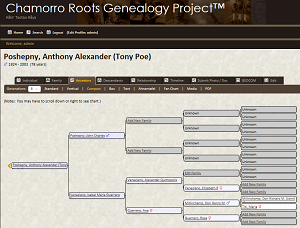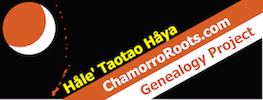Home
Site Upgrade/Maintenance Notice
- Details
- Written by: Bernard Punzalan
Happy New Year!
I will be updating many of the modules of this website to bring it up to par so some screens may not look the same or may be inoperable.
These updates should not affect the Chamorro Roots Genealogy Project Database, but if it does or if experience any issues please fill out the Contact Us form to report the issue(s) and I will look into it.
Thanks for your understanding and patience as I apply some of these changes.
John “Kuk/Cook” Fratis (Part III)
- Details
- Written by: Bernard Punzalan
It’s been over four years (2014a & 2014b) since I found any new information on John Fratis. A couple months ago I ran across some text that led me to purchasing (used book) written by Betty John (1998) to see if there was any additional information that her Grandmother, Libby Beaman, may have recorded.
So far the information is faint; however, Libby does mention a person she called “Cook” on June 1, 1879, approximately eight days after arriving on Saint Paul Islands, Alaska, who appears to be John Fratis.
“Our oven is impossible, even if I knew how to bake, so after supper at the Lodge, Cook gives me a little bread or rolls he has baked each day to bring up to the Government House. Cook is the cook who was here with the occupation of troops. He married an Aleut woman and settled here. Naturally the company was only too glad to get him for their Lodge, and he is a good cook by every standard.”
In my previous findings of John Fratis he was a cook. Fratis started out working as a whaler. He made his way to Saint Paul Island sometime in March 1869 as a cook employed by Williams and Havens Company of New London, Connecticut. In October 1870, he married Poleana Scheptina, a native Unangan. From 1870-1890 he worked as a cook and sealer with the Alaska Commercial Company. In 1873, there was an attempt by the Alaska Commercial Company to convince the Unangan Chiefs to allow John Fratis to share in the sealing and profits. Afterall, John was “a Spanish Creole native of Guam.” However, the old practices of Russian law prevailed and this privilege restricted to only natives was sustained. Later that practice would change and John became a Sealer and shared in on the profits.
For the most part John Fratis spent most of his life on St. Paul Island except for the year 1872-73, which he spent at San Francisco because of ill health. Also, from 1891-92 he and his family wintered at St. George Island, where he worked as cook for the North American Commercial Company. Afterwards he and his family returned back to St. Paul Island where he would live out the remainder of his life (died in 1906).
-----------------------------
Bibliography
Betty John. 1998. Libby: The Sketches, Letters & Journal of Libby Beaman, Recorded in the Pribilof Islands 1879-1880 as present by her Granddaughter Betty John. Council Oaks Books. Tulsa, Oklahoma.
Lindsay, Betty A. & Lindsay John A. 2008. Pribilof Islands, Alaska: Genealogy and Census (U.S. D U.S. Dept. of Com., NOAA Technical Memorandum NOS ORR 18). Government Printing Office: Washington, D.C.
Bernard Punzalan. 2014a. The Beginning of Taotao Håya-Unangan (Chamorro-Aleut) Clan: The Legacy of John Fratis and His Descendants. Chamorro Roots Genealogy Project. From: https://www.chamorroroots.com/v7/index.php/49-taotao-tano/history/297-the-beginning-of-the-taotao-haya-unangan-chamorro-aleut-clan-the-legacy-of-john-fratis-and-his-descendants
Bernard Punzalan. 2014b. John Fratis and His Descendants (Part II). Chamorro Roots Genealogy Project. From: https://www.chamorroroots.com/v7/index.php/home/collaborators/49-taotao-tano/history/295-john-fratis-and-his-descendants-part-ii
Anthony Alexander Poshepny: CIA Agent with CHamoru Roots
- Details
- Written by: Bernard Punzalan
Also Known As: Tony Poe or Tony Po

It never fails me to come across and read some interesting stories of people with CHamoru heritage. This particular one is about Anthony Alexander Poshepny.
What triggered me to look into the Poshepny family was a message that I received on September 10, 2018 from a family member that read, “My grandmother Isabel Mary Veneziano Poshepny was the first beauty queen of Guam in 1916. She was the granddaughter of Henry Mellinchamp.” At this point, I don’t want to disclose that person’s name until I am able to establish a dialogue with her.
Knowing my distant relationship with the Millinchamp’s I wanted to check if I was related to the sender of the message. It turns out that I wasn’t, but because I had very little information on the Poshepny family, I did what I typically do: research and enter in as many names of their family as I could locate and identify.
I did already have Anthony’s name in the database, but he was the only name I had and discovered he had other siblings. Below is a screen shot of his ancestry. His CHamoru ancestry can be traced through his maternal lineage and with the Guerrero surname.

A quick internet search on Anthony Alexander Poshepny will bring up a slew of pages that tell parts of his story as a Marine, CIA Agent, and his key role “training the US-funded secret army in Laos during the Vietnam War.”
The other thing that struck me and although speculative, and he denied it, is that he may have been a source of inspiration towards the role of Colonel Walter Kurtz in the 1979 movie Apocalypse Now.
This information is still fresh with me so I will hold off on saying anything more until I am able to read and learn more about him. But wow! I couldn’t resist in sharing this part so far.
Bibliography
___. 2013. Anthony Poshepny. From: https://en.wikipedia.org/wiki/Anthony_Poshepny, accessed September 10, 2018.
Pale’ Eric Forbes. 2015. Siha Veneziano. From: http://paleric.blogspot.com/2015/07/siha-veneziano.html, accessed September 10, 2018.
John Prados. 2013. The Biography of “Tony Po,” AKA Anthony Poshepny. From: https://unredacted.com/2013/10/15/the-biography-of-tony-po-aka-anthony-poshepny/, accessed September 10, 2018.
Bernard Punzalan. 2018. Anthony Alexander (Tony Poe). From: https://www.chamorroroots.com, accessed September 10, 2018.
Indices of the 1920 & 1930 Census of Guam
- Details
- Written by: Bernard Punzalan


- Exclusively with a subscripton to the annual plan; or,
- Purchasing the eBooks separately. Again, the funds raised from these proceeds are used to offset the costs and maintenance of the Project, website, computer hardware and software, publications, presentations, and other resources (i.e. electronic access to other information/publications) that complements the Project.
The First: First Lady (CHamoru) of the Mariana Islands
- Details
- Written by: Bernard Punzalan
Q: Who was the first woman of CHamoru descent to become a Governor's wife?
A: Maria Anderson Tudela, who married Governor Francisco Moscoso in 1870.
Page 29 of 84

